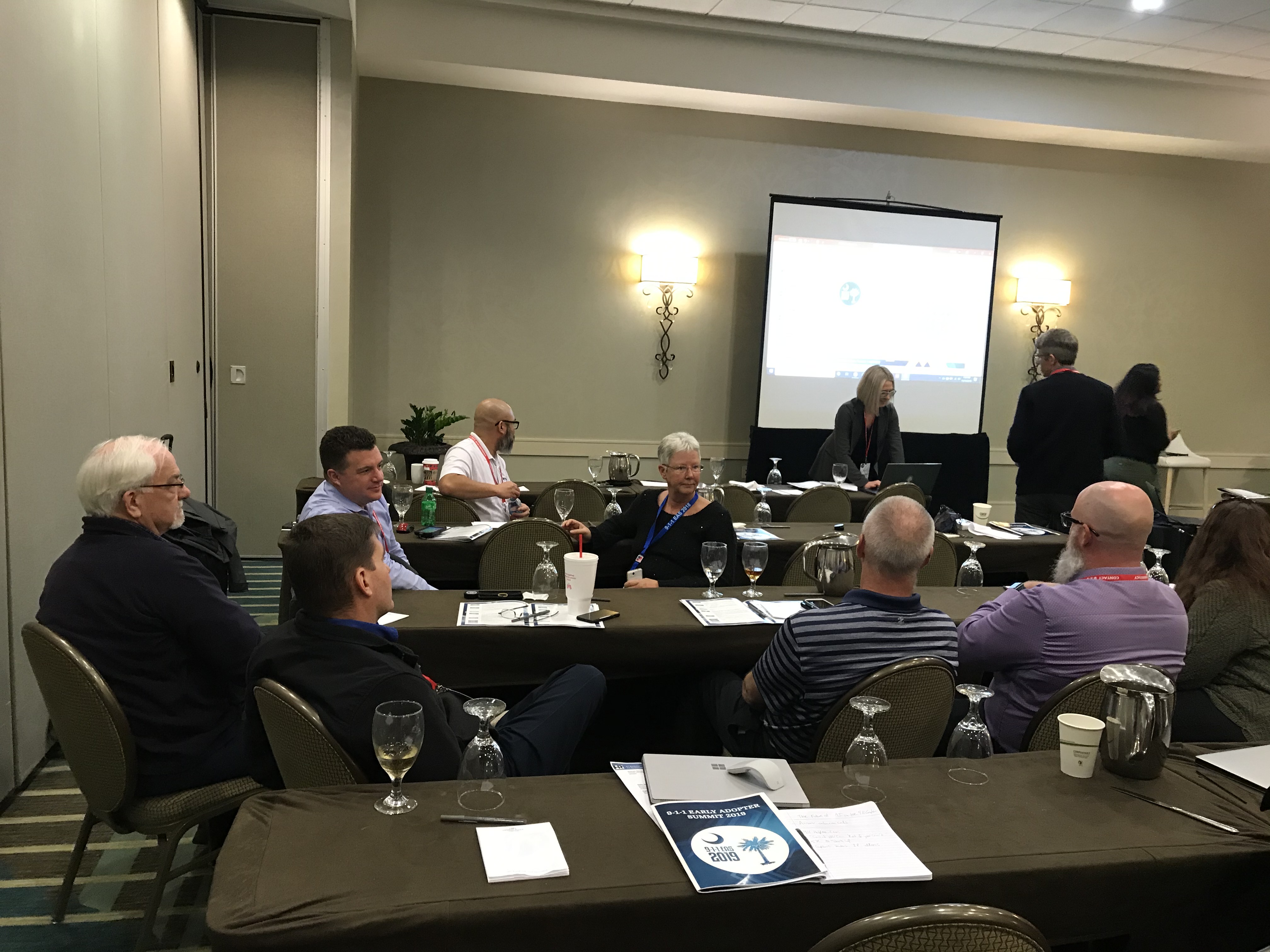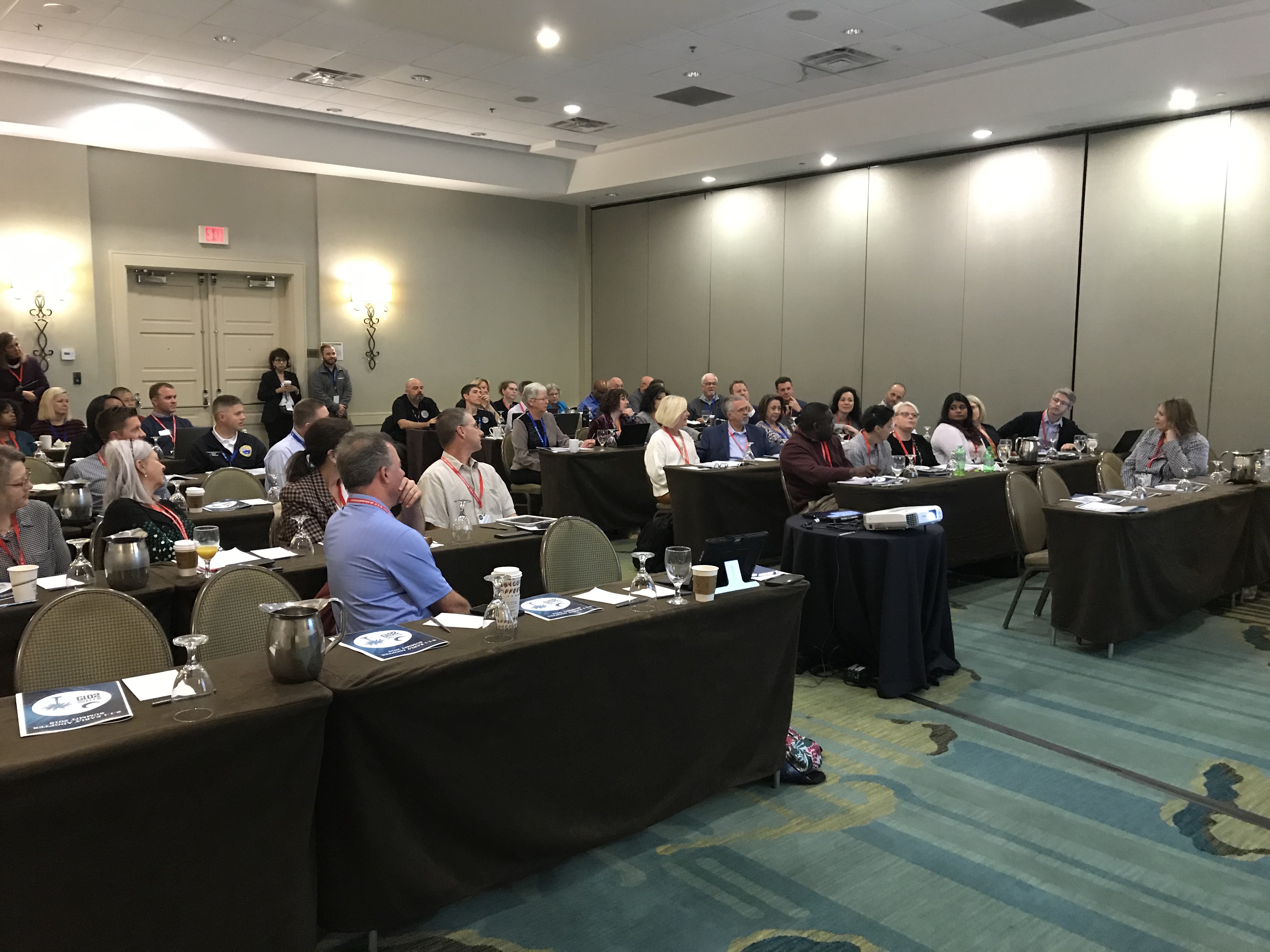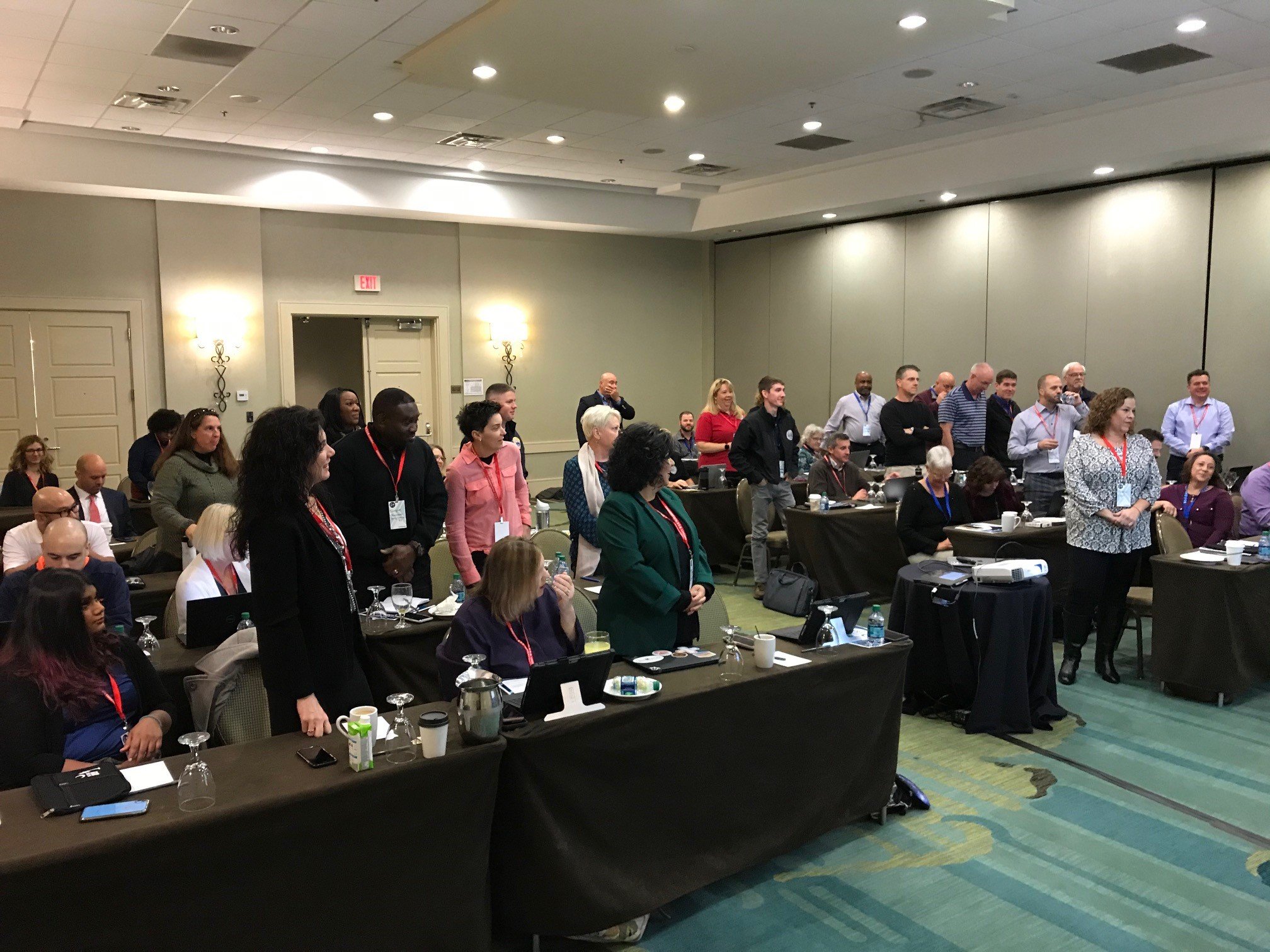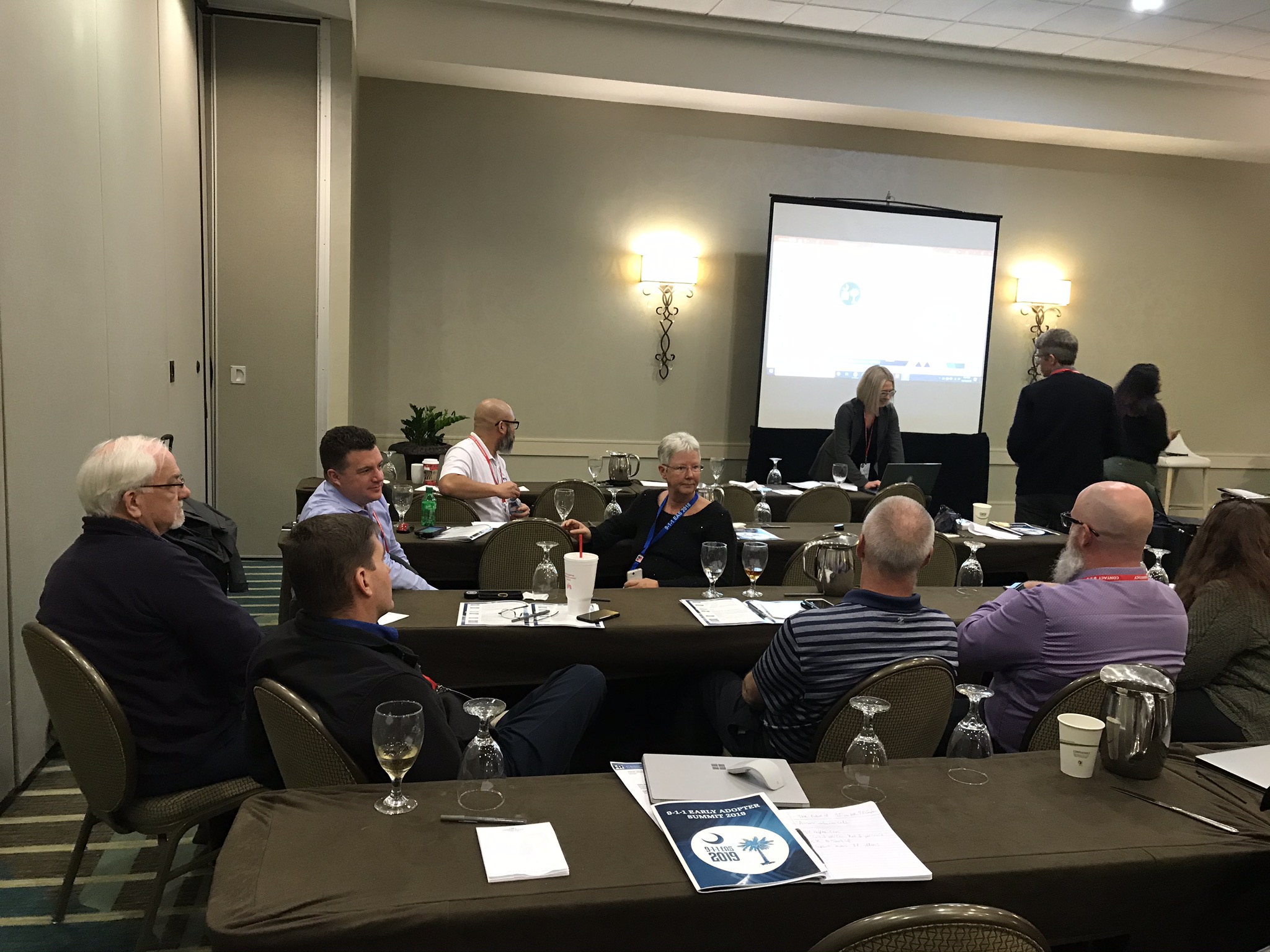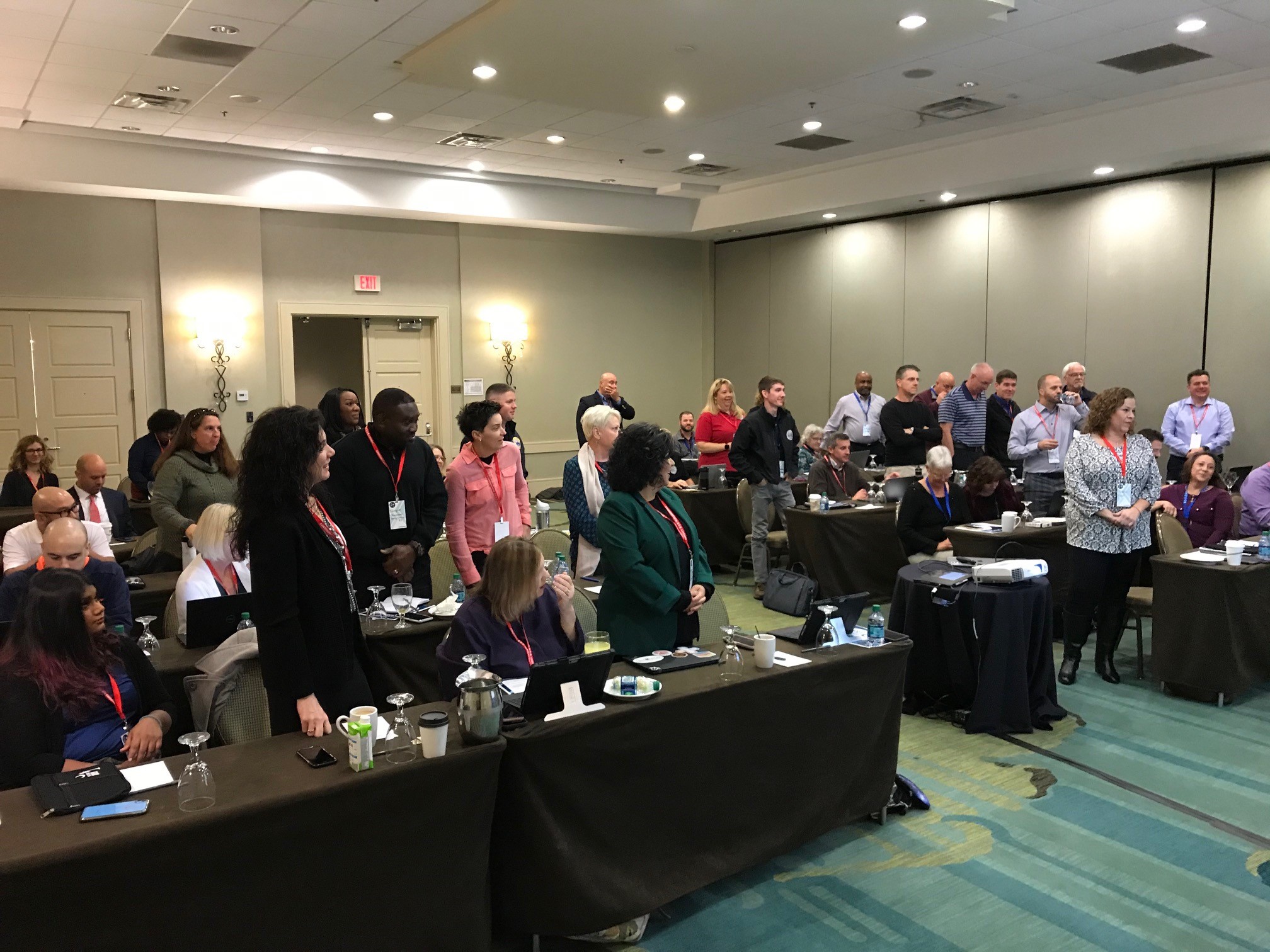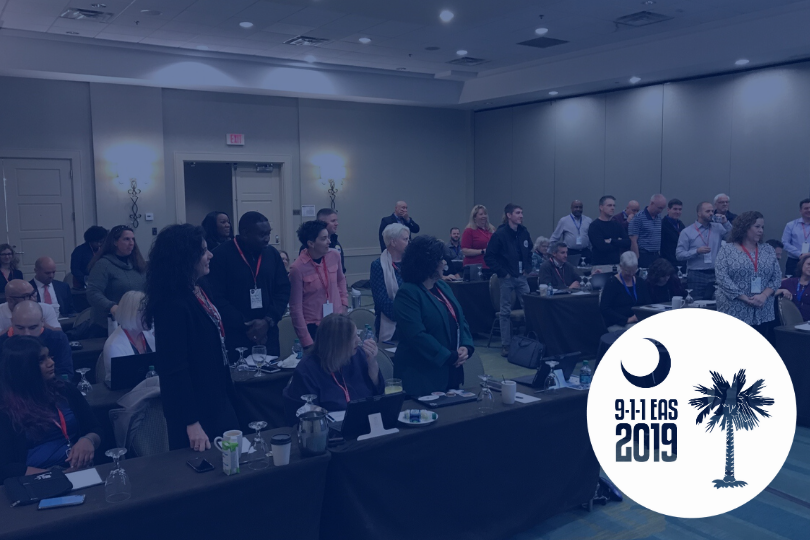
In a quiet conference room in Charleston, South Carolina, a group of 9-1-1 careerists listened to a simulated 9-1-1 call. It was a situation they, or their staff, had come across hundreds of times before: a report of a residential break in from a security company. This is something 9-1-1 call takers handle daily, and one that takes a lot of manpower away from life-threatening emergency calls. But in this simulation, the call taker was artificial intelligence.
When this group began their careers in the emergency number industry, few thought they would one day listen to a robot answering a 9-1-1 call. And for many in the industry, the idea is too scary to even consider. But this group was made up of 9-1-1 Early Adopters, pioneers in innovation who work to improve public safety through cutting edge technology and best practices, and they’re not afraid.
Once a year, 9-1-1 Early Adopters across the nation gather to discuss their latest projects and to share and improve emergency number innovations. The Early Adopter Summit (EAS) is a small gathering by design, with less than 60 attendees in Charleston this year.
“Somebody has to be first,” said Jim Lake, director of Charleston County Consolidated 9-1-1 Center and host of the 2019 EAS. “We’re it.”
The first EAS was hosted in 2017 by the North Central Texas Emergency Communications District (NCT9-1-1) and is the brainchild of Lake, NCT9-1-1 Director Christy Williams, and Maricopa County 9-1-1 Administrator Liz Graeber. In the three years that the summit has taken place, attendees have seen everything from bleeding edge tech to newly minted operation protocols. A few weeks ago, they gathered to discuss the future of 9-1-1 innovation and what they can do to mold it.
Data with a Purpose
Video and pictures in the Public Safety Answering Point (PSAP) is just the beginning of the kind of information that can be integrated into call takers’ equipment. With the rise of IoT (Internet of Things), the industry can expect to see more of a push for additional data. But EAS attendees made it clear that analytics would only be useful if they drove a telecommunicator’s decision making.
The information 9-1-1 agencies will utilize in the future include what is gathered from social media, quality video and photographs, and Z-Axis data that will assist in location accuracy.
Gathering Information from Social Media
After disasters like Hurricane Harvey, where public safety agencies saw a spike in 9-1-1 requests through social media, it is no longer an option for the industry to ignore platforms like Twitter and Facebook. At the 2019 EAS, researchers from the 3C Informatics Research Team presented their ongoing research on using social media in relation to emergency services.
“Our broad research right now is this vision that we call ‘help by any means,’” said Dr. Jess Kropczynski of the University of Cincinnati. “We understand that this is a room full of innovators and early adopters, and we envision a future where [it is] not just picking up a phone call…but how can we incorporate help by any means and how we can think of a multitude of ways to request help.”
One of the biggest impediments experienced by this group, according to Kropzunski, was how to extract “actionable information” from the abundance of data found on these social platforms like Twitter. The researchers are utilizing Twitter data sets coded to train machine learning based on the six “Ws” (who, what, when where, why, and weapons). Their research also led them to discover the “Golden Tweet” — a hypothetical tweet that includes all necessary information a telecommunicator will need to take action in assisting this person. The 3C Informatics team utilized the EAS attendees to gain insight on how their research can best be put into the PSAP and to begin building a set of protocols that 9-1-1 agencies may utilize to process the data.
Facebook also attended the event to share how to request emergency data provided by the platform that is available to government agencies. Currently, 9-1-1 employees can pull data such as address information, photos, messages, and more to assist in a life or death emergency. Employees can visit Facebook.com/records to request this information, and the only prerequisite is a government email address and the full URL of the Facebook profile in question.
Show Me Your Emergency
Though new data from IoT is making strides in multiple industries (including public safety), there is still much that can be done with imagery in the PSAP. The Chandler Police Department has been using imagery and visual tools like video messaging, traffic cameras, maps, and more to assist its telecommunicators.
“What we’ve done in our center is not necessarily about one specific technology, like video-to-9-1-1…it’s about using visual cues in the decision-making process,” said Chandler PD Communications Manager Michelle Potts. She demonstrated how tools like medical alert data paired with a live mapping environment with breadcrumbing may change how a call taker responds to a call.
Potts emphasized the department’s focus on “the headlines,” or the big picture, so telecommunicators don’t get lost in the details and the agency can stick to their single message: whatever technology they adopt must assist in risk management and give better information than what they already had.
Finding the Z-Axis
In October, the Federal Communications Commission proposed that location information provided to 9-1-1 call takers have a “z-axis accuracy metric of plus or minus 3 meters for 80% of wireless E911 calls for z-axis capable handsets.” Representatives from Google discussed what can be done with ELS (Emergency Location Service) on Android devices to help achieve this goal. Currently, Android devices utilize meters above ellipsoid to determine the z-axis, which occasionally comes through on the ALI screen. Based on ALI formats, many are not receiving any z-axis information. Only a handful of early adopters found this information useful as it was currently presenting.
“We have a nice circle and it looks great in math, but the reality is that the Earth is not a circle,” said Boone Spooner of Google. “So what this means is that when we’re reporting height, we may actually report a negative elevation.”
Researchers at Google are trying to find out if the proposed methodology is “confusing,” said Spooner. The presentation focused on how the information collected by Google can be accurately translated to the PSAP and then onto the first responder. Something as simple as terminology (floor versus level, for example) has a huge impact on the actionability of the z-axis information. The EAS attendees spoke from experience to guide Google in locating useful ways to improve this technology, and ended with the intention to continue the conversation with a focus group in the near future.
No Longer Just a Phone Call
As new technology emerges, it is difficult to classify a request for emergency service as only a “call.” Every day new ways to reach 9-1-1 pop up as smart phone applications or through voice command tools, and rather than running from this new trend, Early Adopters look into how they can make it work for their telecommunicators and citizens.
911HELPME.com
Charleston County Consolidated 9-1-1 Center discussed their web-based tool that acts as an alternative to calling 9-1-1. Citizens can visit 911HELPME.org and fill out the form on the homepage to reach a telecommunicator. This tool can be used during disasters in the region when calls or texts to 9-1-1 become overwhelmed.
A citizen who needs to utilize the site must enter a valid address, which gets the request to the correct PSAP. The tool can also accept data from smart device applications built as alternatives to dialing 9-1-1, a rising problem in the industry since many apps cannot connect to the PSAP directly and leave users with a false sense of security.
“Our hope is to work with companies like Facebook and if you have an emergency event occurring and you’ve got all of this data, images, IP addresses…send it here and we’ll get it to the right PSAP,” said Jim Lake.
Preparing Our People for What’s Next
The Early Adopter Summit is more than just a place to discuss new technology. Attendees also get together to challenge each other on how to implement innovations in their agencies. Best practices and lessons learned on projects that may have struggled to get off the ground are discussed. Strangers continue to meet the needs of their people while still keeping innovation and the future of 9-1-1 in mind are identified.
Continue to Adapt Protocol and Improve Training
It’s difficult to adopt new technology if the day-to-day activity of a PSAP is struggling to meet the expectations of its citizens. Geoff Kuhn of the City of Tucson Public Safety Communications 9-1-1 presented on the challenge of updating protocols after a merge of fire/EMS telecommunicators with the police department’s agencies. To improve on lengthy wait times, performance issues, and citizen complaints, the agency had to change their approach to protocol, Kuhn said.
This included focusing on criteria-based dispatching (CBD) and encouraging call takers to ask what they needed to know versus what they wanted to know in order to reduce requests for additional information. They rewrote everything in narrative format to make their content digestible for officers and telecommunicators alike. This process also included providing regular quality assurance, or quality improvement, which meant all telecommunicators had their calls pulled on their days off and were then reviewed and discussed upon their return.
By focusing on guidelines rather than scripted protocols, the city of Tucson saw their staff members improve and adapt to the new environment.
Prepare Operations for Technology
An agency cannot innovate while maintaining the same culture from 20 years ago. As the technology within 9-1-1 changes, so must the policies and guidelines of a PSAP.
“Success of innovative tech depends on how we implement it on the operational side,” said Stacy Needham of Manatee County, who presented on the topic.
Needham taught her top lessons learned when implementing new innovative tech, which included having your leadership team on board from the beginning and preparing staff members with “comfort training,” which brought together new telecommunicators and veterans to discuss a new technology product long before it is introduced to allow for questions and preparation. Needham also introduced the challenge room: creating a small team of technical and operational staff members who gather to create SOPs for new integrations. The goal of the challenge room is not to find the perfect solution, said Needham, but to identify best practices.
NCT9-1-1 presented on their Generational Advisory Board (GAB), which is made up of younger individuals not employed by the district who meet to propose suggestions on policies and protocol. The GAB’s goal is to allow the voices of the future work force help define the work culture they’ll soon join.
Don’t Wait for Tomorrow
9-1-1 Early Adopters are gathering today to prepare for a future that isn’t here yet. The road to Next Generation 9-1-1 has been a long one, and those in the industry know it still has a long way to go. But it’s coming whether the industry is ready for it or not. That is why events like the Early Adopter Summit are important to assist both innovators in 9-1-1 and those following in their footsteps. It’s a place where tomorrow is something to look forward to rather than be afraid of, and where we can’t wait to see what happens next.
